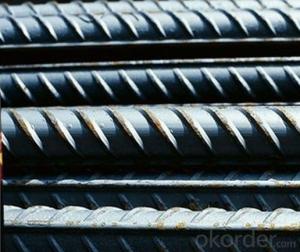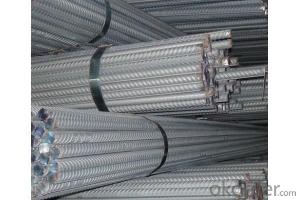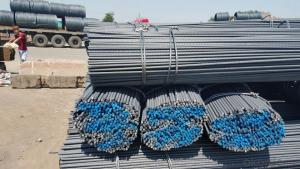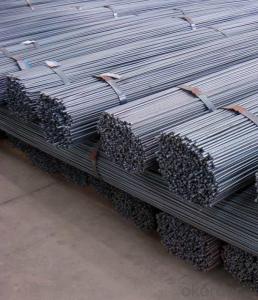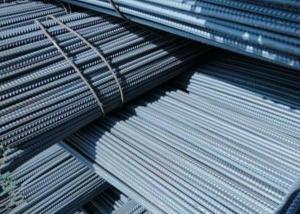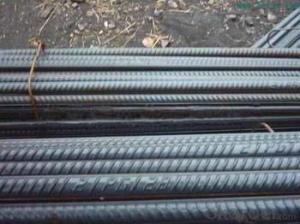High Quality Steel Rebar
- Loading Port:
- China Main Port
- Payment Terms:
- TT OR LC
- Min Order Qty:
- -
- Supply Capability:
- -
OKorder Service Pledge
Quality Product, Order Online Tracking, Timely Delivery
OKorder Financial Service
Credit Rating, Credit Services, Credit Purchasing
You Might Also Like
Quick Details
Standard:AISI, ASTM, BS, DIN, GB, JIS
Grade:HRB335
Diameter:6mm-15mm
Length:6m,9m,12m or others
Place of Origin:China (Mainland)
Model Number:001
Application:building
Packaging & Delivery
| Packaging Details: | bundle with steel wire rod |
|---|---|
| Delivery Detail: | 15-30 days after get your deposit. |
- Q: How do steel rebars contribute to the overall sustainability of concrete structures?
- Concrete structures benefit from the presence of steel rebars in various ways, thereby contributing to their overall sustainability. To start with, the durability and lifespan of concrete structures are significantly enhanced by steel rebars. By reinforcing the concrete, rebars provide additional strength and prevent cracks or structural failures, thereby extending the structure's life. This reduces the need for frequent repairs or replacements, conserving resources and minimizing the environmental impact of construction activities. Furthermore, steel rebars are entirely recyclable. When a structure reaches the end of its life cycle, the rebars can be easily extracted and recycled, reducing the demand for new raw materials and minimizing waste. This not only conserves natural resources but also reduces greenhouse gas emissions associated with the extraction and production of fresh steel. Incorporating steel rebars into concrete structures also allows for the use of thinner concrete sections. By using less concrete, the demand for cement, a significant source of carbon dioxide emissions during production, is reduced. Therefore, the use of steel rebars helps to lower the overall carbon footprint of concrete structures. Moreover, steel rebars can be designed to resist corrosion, which is a common problem in concrete structures exposed to harsh environments or coastal areas. By providing protection against corrosion, the rebars increase the service life of the structure, reducing the need for maintenance and repairs. This not only saves costs but also reduces the environmental impact associated with maintenance activities. In conclusion, steel rebars play a vital role in enhancing the sustainability of concrete structures by improving their durability, enabling recycling, reducing material consumption, and minimizing maintenance requirements. By incorporating steel rebars into concrete construction, we can create long-lasting, environmentally-friendly structures that contribute to a more sustainable built environment.
- Q: What is the importance of proper anchoring of steel rebars in concrete?
- Proper anchoring of steel rebars in concrete is of utmost importance as it ensures structural integrity and enhances the overall strength and durability of the concrete structure. The anchoring process securely holds the rebars in place, preventing them from shifting or slipping under various loads and stresses. This, in turn, helps in maintaining the desired design strength, resisting cracking, and providing adequate reinforcement to withstand external forces such as earthquakes, wind, and other dynamic loads. In essence, proper anchoring of steel rebars is critical in ensuring the long-term stability and safety of concrete structures.
- Q: How do steel rebars affect the overall structural integrity of a building?
- Steel rebars play a crucial role in enhancing the overall structural integrity of a building. By reinforcing and strengthening concrete structures, rebars effectively distribute loads and resist tension, preventing cracks and structural failures. This reinforcement enables buildings to withstand various forces, such as earthquakes and high winds, ensuring their stability and durability over time.
- Q: Why is the price of screw steel affected by iron ore and coal?
- The required material is simple, "billet, iron ore with a small amount of chemical elements", and then through the hot rolling method of refining, during which a large amount of coal is needed, so the price of rebar will be affected by iron ore and coal
- Q: Can steel rebars be used in structures with limited construction equipment?
- Indeed, structures with limited construction equipment can utilize steel rebars. These versatile elements can be effortlessly handled and installed with minimal equipment. One can easily cut them to the desired size using handheld tools like bolt cutters or torches, thereby eliminating the necessity for bulky machinery. Additionally, their lightweight nature facilitates convenient transportation and maneuvering on-site. The flexibility of steel rebars permits the application of diverse construction techniques, such as interlacing them with wire or employing wire mesh to fortify concrete. To summarize, steel rebars prove to be a practical option for structures lacking extensive construction machinery, offering both strength and durability.
- Q: Can steel rebars be used in structures with high chemical exposure?
- No, steel rebars should not be used in structures with high chemical exposure because they are prone to corrosion and may deteriorate over time.
- Q: How are steel rebars identified based on their grades?
- Steel rebars are identified based on their grades through markings or labels on the surface of the rebars. These markings typically indicate the grade of the steel rebars, which is determined by the strength and composition of the steel.
- Q: What are the guidelines for proper storage and transportation of steel rebars?
- The guidelines for proper storage and transportation of steel rebars include keeping them off the ground to avoid moisture and corrosion, storing them in a well-ventilated area, organizing them in a neat and stable manner to prevent falling or shifting, protecting them from direct exposure to weather conditions, and securing them properly during transportation to avoid damage or accidents.
- Q: What is the role of steel rebars in foundation slabs?
- Steel rebars play a crucial role in foundation slabs by providing reinforcement and strength. They are embedded within the concrete to increase its tensile strength, prevent cracking, and enhance its ability to withstand heavy loads and forces. This reinforcement helps distribute the load evenly across the foundation slab, ensuring its stability and durability over time.
- Q: How do steel rebars contribute to the overall sustainability of a structure?
- Steel rebars contribute to the overall sustainability of a structure by increasing its durability, strength, and longevity. By reinforcing concrete, rebars help prevent cracks and structural failures, reducing the need for costly repairs or replacements. This contributes to the long-term sustainability of a structure as it minimizes waste and resource consumption. Additionally, steel rebars can be recycled at the end of a structure's life, reducing the environmental impact and promoting a circular economy.
Send your message to us
High Quality Steel Rebar
- Loading Port:
- China Main Port
- Payment Terms:
- TT OR LC
- Min Order Qty:
- -
- Supply Capability:
- -
OKorder Service Pledge
Quality Product, Order Online Tracking, Timely Delivery
OKorder Financial Service
Credit Rating, Credit Services, Credit Purchasing
Similar products
Hot products
Hot Searches
Related keywords
